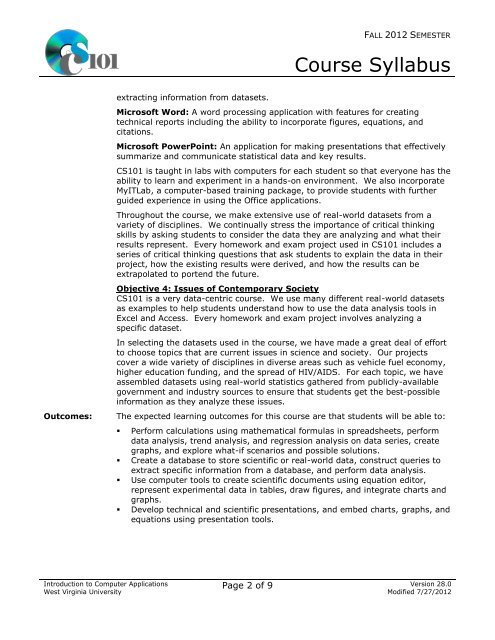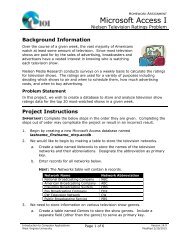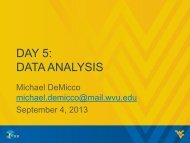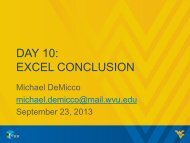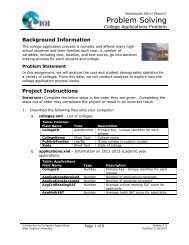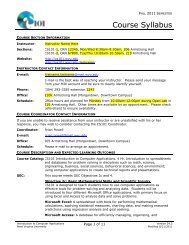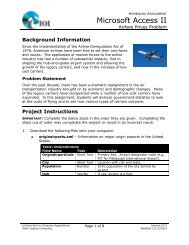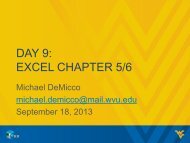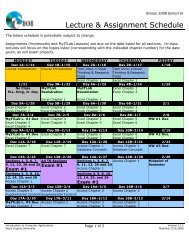Course Syllabus - Computer Science 101 - West Virginia University
Course Syllabus - Computer Science 101 - West Virginia University
Course Syllabus - Computer Science 101 - West Virginia University
You also want an ePaper? Increase the reach of your titles
YUMPU automatically turns print PDFs into web optimized ePapers that Google loves.
FALL 2012 SEMESTER<br />
<strong>Course</strong> <strong>Syllabus</strong><br />
Outcomes:<br />
extracting information from datasets.<br />
Microsoft Word: A word processing application with features for creating<br />
technical reports including the ability to incorporate figures, equations, and<br />
citations.<br />
Microsoft PowerPoint: An application for making presentations that effectively<br />
summarize and communicate statistical data and key results.<br />
CS<strong>101</strong> is taught in labs with computers for each student so that everyone has the<br />
ability to learn and experiment in a hands-on environment. We also incorporate<br />
MyITLab, a computer-based training package, to provide students with further<br />
guided experience in using the Office applications.<br />
Throughout the course, we make extensive use of real-world datasets from a<br />
variety of disciplines. We continually stress the importance of critical thinking<br />
skills by asking students to consider the data they are analyzing and what their<br />
results represent. Every homework and exam project used in CS<strong>101</strong> includes a<br />
series of critical thinking questions that ask students to explain the data in their<br />
project, how the existing results were derived, and how the results can be<br />
extrapolated to portend the future.<br />
Objective 4: Issues of Contemporary Society<br />
CS<strong>101</strong> is a very data-centric course. We use many different real-world datasets<br />
as examples to help students understand how to use the data analysis tools in<br />
Excel and Access. Every homework and exam project involves analyzing a<br />
specific dataset.<br />
In selecting the datasets used in the course, we have made a great deal of effort<br />
to choose topics that are current issues in science and society. Our projects<br />
cover a wide variety of disciplines in diverse areas such as vehicle fuel economy,<br />
higher education funding, and the spread of HIV/AIDS. For each topic, we have<br />
assembled datasets using real-world statistics gathered from publicly-available<br />
government and industry sources to ensure that students get the best-possible<br />
information as they analyze these issues.<br />
The expected learning outcomes for this course are that students will be able to:<br />
• Perform calculations using mathematical formulas in spreadsheets, perform<br />
data analysis, trend analysis, and regression analysis on data series, create<br />
graphs, and explore what-if scenarios and possible solutions.<br />
• Create a database to store scientific or real-world data, construct queries to<br />
extract specific information from a database, and perform data analysis.<br />
• Use computer tools to create scientific documents using equation editor,<br />
represent experimental data in tables, draw figures, and integrate charts and<br />
graphs.<br />
• Develop technical and scientific presentations, and embed charts, graphs, and<br />
equations using presentation tools.<br />
Introduction to <strong>Computer</strong> Applications<br />
<strong>West</strong> <strong>Virginia</strong> <strong>University</strong><br />
Page 2 of 9 Version 28.0<br />
Modified 7/27/2012


